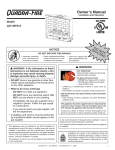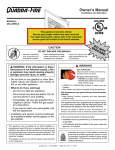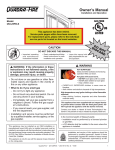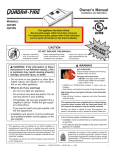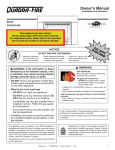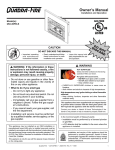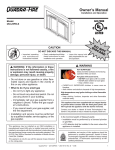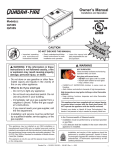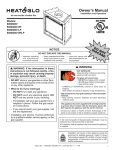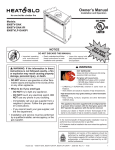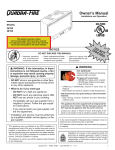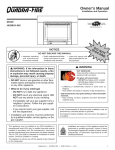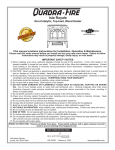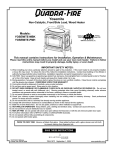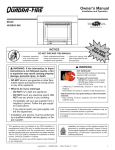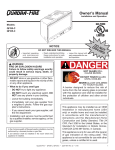Download Quadra-Fire QVI35 Owner`s manual
Transcript
Owner’s Manual R Installation and Operation Model: QVI-35FB-S NOTICE DO NOT DISCARD THIS MANUAL • Important operating and maintenance instructions included. • Read, understand and follow these instructions for safe installation and operation. WARNING: If the information in these instructions is not followed exactly, a fire or explosion may result causing property damage, personal injury, or death. • DO NOT store or use gasoline or other flammable vapors and liquids in the vicinity of this or any other appliance. • What to do if you smell gas - DO NOT try to light any appliance. - DO NOT touch any electrical switch. DO NOT use any phone in your building. - Immediately call your gas supplier from a neighbor’s phone. Follow the gas supplier’s instructions. - If you cannot reach your gas supplier, call the fire department. • Installation and service must be performed by a qualified installer, service agency, or the gas supplier. This appliance may be installed as an OEM installation in manufactured home (USA only) or mobile home and must be installed in accordance with the manufacturer’s instructions and the manufactured home construction and safety standard, Title 24 CFR, Part 3280 or Standard for Installation in Mobile Homes, CAN/CSA Z240MH, in Canada. This appliance is only for use with the type(s) of gas indicated on the rating plate. • Leave this manual with party responsible for use and operation. D DI O N SC OT AR D WARNING HOT SURFACES! Glass and other surfaces are hot during operation AND cool down. Hot glass will cause burns. • DO NOT touch glass until it is cooled • NEVER allow children to touch glass • Keep children away • CAREFULLY SUPERVISE children in same room as fireplace. • Alert children and adults to hazards of high temperatures. High temperatures may ignite clothing or other flammable materials. • Keep clothing, furniture, draperies and other flammable materials away. This appliance has been supplied with an integral barrier to prevent direct contact with the fixed glass panel. DO NOT operate the appliance with the barrier removed. Contact your dealer or Hearth & Home Technologies if the barrier is not present or help is needed to properly install one. In the Commonwealth of Massachusetts installation must be performed by a licensed plumber or gas fitter. A CO detector shall be installed in the room where the appliance in installed. Installation and service of this appliance should be performed by qualified personnel. Hearth & Home Technologies suggests NFI certified or factory trained professionals, or technicians supervised by an NFI certified professional. Quadra-Fire • QVI-35FB-S • 2178-900 Rev. D • 9/09 1 Read this manual before installing or operating this appliance. Please retain this owner’s manual for future reference. A. Congratulations This Owner’s Manual should be retained for future reference. We suggest that you keep it with your other important documents and product manuals. Congratulations on selecting a Quadra-Fire gas fireplace, an elegant and clean alternative to wood burning fireplaces. The Quadra-Fire gas fireplace you have selected is designed to provide the utmost in safety, reliability, and efficiency. The information contained in this Owner’s Manual, unless noted otherwise, applies to all models and gas control systems. Your new Quadra-Fire gas fireplace will give you years of durable use and trouble-free enjoyment. Welcome to the Quadra-Fire family of fireplace products! As the owner of a new fireplace, you’ll want to read and carefully follow all of the instructions contained in this Owner’s Manual. Pay special attention to all cautions and warnings. Homeowner Reference Information We recommend that you record the following pertinent information about your fireplace. Model Name: ___________________________________________ Date purchased/installed: __________________ Serial Number:__________________________________________ Location on fireplace: _____________________ Dealership purchased from: _______________________________ Dealer Phone: __________________________ Notes: _______________________________________________________________________________________ _____________________________________________________________________________________________ Listing Label Information/Location The model information regarding your specific fireplace can be found on the rating plate usually located in the control area of the fireplace. This product may be covered by one or more of the following patents: (Nos produits sont couverts par un ou plusieurs des brevets suivants): (United States) 4593510, 4686807, 4766876, 4793322, 4811534, 5000162, 5016609, 5076254, 5113843, 5191877, 5218953, 5263471, 5328356, 5341794, 5347983, 5429495, 5452708, 5542407, 5601073, 5613487, 5647340, 5688568, 5762062, 5775408, 5890485, 5931661, 5941237, 5947112, 5996575, 6006743, 6019099, 6048195, 6053165, 6145502, 6170481, 6237588, 6296474, 6374822, 6413079, 6439226, 6484712, 6543698, 6550687, 6601579, 6672860, 6688302B2, 6715724B2, 6729551, 6736133, 6748940, 6748942, D320652, D445174, D462436; (Canada)1297749, 2195264, 2225408; or other U.S. and foreign patents pending (ou autres brevets americains et etrangers en attente). R Type of Gas Quadra-Fire, a brand of Hearth & Home Technologies, Inc. 7571 215th Street West, Lakeville, MN 55044 Not for use with solid fuel. (Ne doit pas entre utilise avec un combustible solide). Type of Gas (Sorte De Gaz): Gas and Electric Information NATURAL GAS This appliance must be installed in accordance with local codes, if any; if not, follow ANSI Z223.1 in the USA or CAN/CGA B149 installation codes. (Installer l’appareil selon les codes ou reglements locaux ou, en l’absence de tels reglements, selon les codes d’installation CAN/CGA-B149.) ANSI Z21XX-XXXX · CSA 2.XX-MXX · UL307B Minimum Permissible Gas Supply for Purposes of Input Adjustment. Approved Minimum (De Gaz) Acceptable 0.0 in w.c. (Po. Col. d’eau) Maximum Pressure (Pression) 0.0 in w.c. (Po. Col. d’eau) Maximum Manifold Pressure (Pression) 0.0 in w.c. (Po. Col. d’eau) Minimum Manifold Pressure (Pression) 0.0 in w.c. (Po. Col. d’eau) Total Electrical Requirements: 000Vac, 00Hz., less than 00 Amperes ALTITUDE: MAX. INPUT BTUH: MIN. INPUT BTUH: ORIFICE SIZE: 2 0-0000 FT. 00,000 00,000 #XXXXX IN CANADA 0000-0000FT. 00,000 00,000 #XXXXX MADE IN USA Model: (Modele): XXXXXXXX Serial (Serie): XXXXXXXX Quadra-Fire • QVI-35FB-S • 2178-900 Rev. D • 9/09 Model Number Serial Number Safety Alert Key: • • • • DANGER! Indicates a hazardous situation which, if not avoided will result in death or serious injury. WARNING! Indicates a hazardous situation which, if not avoided could result in death or serious injury. CAUTION! Indicates a hazardous situation which, if not avoided, could result in minor or moderate injury. NOTICE: Used to address practices not related to personal injury. Table of Contents A. Congratulations . . . . . . . . . . . . . . . . . . . . . . . . . . . . . . . . . 2 B. Limited Lifetime Warranty . . . . . . . . . . . . . . . . . . . . . . . . . . 4 1 Listing and Code Approvals A. B. C. D. E. F. Appliance Certification . . . . . . . . . . . . . . . . . . . . . . . . . . . . BTU Specifications . . . . . . . . . . . . . . . . . . . . . . . . . . . . . . . High Altitude Installations . . . . . . . . . . . . . . . . . . . . . . . . . . Non-Combustible Materials Specification. . . . . . . . . . . . . . Combustible Materials Specification . . . . . . . . . . . . . . . . . Electrical Codes . . . . . . . . . . . . . . . . . . . . . . . . . . . . . . . . . 6 6 6 6 6 6 User Guide 2 Operating Instructions A. B. C. D. E. F. G. H. I. J. Gas Fireplace Safety . . . . . . . . . . . . . . . . . . . . . . . . . . . . . 7 Your Fireplace . . . . . . . . . . . . . . . . . . . . . . . . . . . . . . . . . . 7 Clear Space . . . . . . . . . . . . . . . . . . . . . . . . . . . . . . . . . . . . 8 Decorative Doors, Fronts and Surrounds . . . . . . . . . . . . . . 8 Fixed Glass Assembly . . . . . . . . . . . . . . . . . . . . . . . . . . . . 8 Remote Controls, Wall Controls and Wall Switches . . . . . . 8 Before Lighting Fireplace . . . . . . . . . . . . . . . . . . . . . . . . . . 8 Standing Pilot Ignition. . . . . . . . . . . . . . . . . . . . . . . . . . . . . 9 After Appliance is Lit . . . . . . . . . . . . . . . . . . . . . . . . . . . . . 10 Frequently Asked Questions . . . . . . . . . . . . . . . . . . . . . . 10 3 Maintenance and Service A. Maintenance Tasks-Homeowner . . . . . . . . . . . . . . . . . . . 11 B. Maintenance Tasks-Service Technician . . . . . . . . . . . . . . 12 A. B. C. D. E. F. Inspection and Cleaning . . . . . . . . . . . . . . . . . . . . . . . . . . Flue Damper. . . . . . . . . . . . . . . . . . . . . . . . . . . . . . . . . . . Gas Line . . . . . . . . . . . . . . . . . . . . . . . . . . . . . . . . . . . . . . Hearth or Hearth Extension . . . . . . . . . . . . . . . . . . . . . . . Fireplace Conversion Notice . . . . . . . . . . . . . . . . . . . . . . Electrical Outlet Box . . . . . . . . . . . . . . . . . . . . . . . . . . . . . 20 20 20 20 20 20 8 Installing Vent Pipe and Appliance A. B. C. D. E. F. Vent Limits . . . . . . . . . . . . . . . . . . . . . . . . . . . . . . . . . . . . Venting Components . . . . . . . . . . . . . . . . . . . . . . . . . . . . Connecting Vent Pipe . . . . . . . . . . . . . . . . . . . . . . . . . . . . Placing, Securing and Leveling the Appliance . . . . . . . . . Remote Control . . . . . . . . . . . . . . . . . . . . . . . . . . . . . . . . Installing Adaptor and Termination Cap . . . . . . . . . . . . . . 21 21 21 22 22 23 9 Gas Information A. B. C. D. Fuel Conversion . . . . . . . . . . . . . . . . . . . . . . . . . . . . . . . . Gas Pressure . . . . . . . . . . . . . . . . . . . . . . . . . . . . . . . . . . Gas Connection . . . . . . . . . . . . . . . . . . . . . . . . . . . . . . . . High Altitude Installations . . . . . . . . . . . . . . . . . . . . . . . . . 24 24 24 24 10 Electrical Information A. B. C. D. Wiring Requirements . . . . . . . . . . . . . . . . . . . . . . . . . . . . Standing Pilot Ignition System Wiring . . . . . . . . . . . . . . . Junction Box Installation. . . . . . . . . . . . . . . . . . . . . . . . . . Fan Replacement . . . . . . . . . . . . . . . . . . . . . . . . . . . . . . . 25 25 26 26 11 Finishing Installer Guide A. Mantel and Wall Projections . . . . . . . . . . . . . . . . . . . . . . . 28 Î 4 Getting Started A. B. C. D. 7 Installation Preparation Typical Appliance System. . . . . . . . . . . . . . . . . . . . . . . . . Design and Installation Considerations . . . . . . . . . . . . . . Tools and Supplies Needed . . . . . . . . . . . . . . . . . . . . . . . Inspect Appliance and Components . . . . . . . . . . . . . . . . . 14 16 16 16 5 Fireplace Size Requirements A. Minimum Fireplace Opening . . . . . . . . . . . . . . . . . . . . . . 17 Î B. Mantel and Wall Projections . . . . . . . . . . . . . . . . . . . . . . . 18 6 Termination Locations A. Vent Termination Minimum Clearances . . . . . . . . . . . . . . 19 12 Appliance Setup A. B. C. D. E. F. G. H. Remove Glass Assembly . . . . . . . . . . . . . . . . . . . . . . . . . Remove the Shipping Materials . . . . . . . . . . . . . . . . . . . . Clean the Appliance . . . . . . . . . . . . . . . . . . . . . . . . . . . . . Accessories . . . . . . . . . . . . . . . . . . . . . . . . . . . . . . . . . . . Ember Placement . . . . . . . . . . . . . . . . . . . . . . . . . . . . . . . Install the Log Assembly. . . . . . . . . . . . . . . . . . . . . . . . . . Fixed Glass Assembly . . . . . . . . . . . . . . . . . . . . . . . . . . . Air Shutter Setting . . . . . . . . . . . . . . . . . . . . . . . . . . . . . . 29 29 29 29 Î 29 30 33 33 13 Troubleshooting A. Standing Pilot Ignition System . . . . . . . . . . . . . . . . . . . . . 34 14 Reference Materials A. B. C. D. Appliance Dimension Diagram . . . . . . . . . . . . . . . . . . . . . Vent Kits Components . . . . . . . . . . . . . . . . . . . . . . . . . . . Service Parts List . . . . . . . . . . . . . . . . . . . . . . . . . . . . . . Contact Information . . . . . . . . . . . . . . . . . . . . . . . . . . . . . 36 37 39 41 Î = Contains updated information. Quadra-Fire • QVI-35FB-S • 2178-900 Rev. D • 9/09 3 B. Limited Lifetime Warranty 4 Quadra-Fire • QVI-35FB-S • 2178-900 Rev. D • 9/09 B. Limited Lifetime Warranty (continued) Quadra-Fire • QVI-35FB-S • 2178-900 Rev. D • 9/09 5 1 Listing and Code Approvals A. Appliance Certification B. BTU Specifications Maximum Input BTU/h Minimum Input BTU/h Orifice Size (DMS) US (0-2000 FT) 40,000 27,000 .125 CANADA (2000-4500 FT) 36,000 24,300 31 US (0-2000 FT) 34,000 28,900 50 CANADA (2000-4500 FT) 31,000 19,000 51 Models MODELS: QVI-35B-S LABORATORY: Underwriters Laboratories, Inc. (UL) TYPE: Vented Gas Appliance Heater STANDARD: ANSI Z21.88b-2008/CSA 2.33b-2008 This product is listed to ANSI standards for “Vented Gas Appliance Heaters” and applicable sections of “Gas Burning Heating Appliances for Manufactured Homes and Recreational Vehicles”, and “Gas Fired Appliances for Use at High Altitudes”. Quadra-Fire gas inserts are designed for installations into solid fuel masonry or factory built fireplaces that have been installed in accordance with the National, Provincial, State and local building codes. Fireplaces are to be constructed of non-combustible materials and, in the absence of local or regional codes, meet criteria of NFPA 211. No additional outside air source is required. NOTICE: This installation must conform with local codes. In the absence of local codes you must comply with the National Fuel Gas Code, ANSI Z223.1-latest edition in the U.S.A. and the CAN/CGA B149 Installation Codes in Canada. NOT INTENDED FOR USE AS A PRIMARY HEAT SOURCE. This appliance is tested and approved as either supplemental room heat or as a decorative appliance. It should not be factored as primary heat in residential heating calculations. (U.S. or Canada) QVI-35FB-S (NG) QVI-35FB-S (LP) C. High Altitude Installations NOTICE: If the heating value of the gas has been reduced, these rules do not apply. Check with your local gas utility or authorities having jurisdiction. When installing above 2000 feet elevation: • In the USA: Reduce input rate 4% for each 1000 feet above 2000 feet. • In CANADA: Reduce input rate 10% for elevations between 2000 feet and 4500 feet. Above 4500 feet, consult local gas utility. Check with your local gas utility to determine proper orifice size. D. Non-Combustible Materials Specification Material which will not ignite and burn. Such materials are those consisting entirely of steel, iron, brick, tile, concrete, slate, glass or plasters, or any combination thereof. Materials that are reported as passing ASTM E 136, Standard Test Method for Behavior of Materials in a Vertical Tube Furnace at 750 ºC and UL763 shall be considered non-combustible materials. E. Combustible Materials Specification Materials made of or surfaced with wood, compressed paper, plant fibers, plastics, or other material that can ignite and burn, whether flame proofed or not, or plastered or unplastered shall be considered combustible materials. F. Electrical Codes NOTICE: This appliance must be electrically wired and grounded in accordance with local codes or, in the absence of local codes, with National Electric Code ANSI/NFPA 70-latest edition or the Canadian Electric Code CSA C22.1. • A 110-120 VAC circuit for this product must be protected with ground-fault circuit-interrupter protection, in compliance with the applicable electrical codes, when it is installed in locations such as in bathrooms or near sinks. 6 Quadra-Fire • QVI-35FB-S • 2178-900 Rev. D • 9/09 2 Operating Instructions User Guide A. Gas Fireplace Safety • Keep remote controls out of reach of children. • Never leave children alone near a hot fireplace, whether operating or cooling down. WARNING • Teach children to NEVER touch the fireplace. HOT SURFACES! Glass and other surfaces are hot during operation AND cool down. • Consider not using the fireplace when children will be present. Hot glass will cause burns. • DO NOT touch glass until it is cooled • NEVER allow children to touch glass • Keep children away • CAREFULLY SUPERVISE children in same room as fireplace. • Alert children and adults to hazards of high temperatures. Contact your dealer for more information, or visit: www. hpba.org/staysafe. To prevent unintended operation when not using your fireplace for an extended period of time (summer months, vacation/trips, etc): • Remove batteries from remote controls. High temperatures may ignite clothing or other flammable materials. • Keep clothing, furniture, draperies and other flammable materials away. • Turn off wall controls. • Turn off gas controls valve on standing pilot models. When lighting the pilot light on fireplaces with a standing pilot, remove the fixed glass assembly so you can detect presence of residual gas build-up. See Standing Pilot Lighting instructions and Maintenance Tasks. This appliance has been supplied with an integral barrier to prevent direct contact with the fixed glass panel. DO NOT operate the appliance with the barrier removed. Contact your dealer or Hearth & Home Technologies if the barrier is not present or help is needed to properly install one. B. Your Fireplace If you expect that small children or vulnerable adults may come into contact with this fireplace, the following precautions are recommended: WARNING! DO NOT operate fireplace before reading and understanding operating instructions. Failure to operate fireplace according to operating instructions could cause fire or injury. • Install a physical barrier such as: - A decorative firescreen. - Adjustable safety gate. • Install a switch lock or a wall/remote control with child protection lockout feature. DECORATIVE DOORS (NOT SHOWN) SECTION 2.D. MANTEL FIXED GLASS ASSEMBLY (NOT SHOWN) SECTION 12.G. HEARTH CLEAR SPACE SECTION 2.C. Figure 2.1 General Operating Parts Quadra-Fire • QVI-35FB-S • 2178-900 Rev. D • 9/09 7 C. Clear Space E. Fixed Glass Assembly WARNING! DO NOT place combustible objects in front of the fireplace or block louvers. High temperatures may start a fire. See Figure 2.2. See Section 12.G. Avoid placing candles and other heat-sensitive objects on mantel or hearth. Heat may damage these objects. F. Remote Controls, Wall Controls and Wall Switches Follow the instructions supplied with the control installed to operate your fireplace: For safety: • Install a switch lock or a wall/remote control with child protection lockout feature. • Keep remote controls out of reach of children. See your dealer if you have questions. G. Before Lighting Fireplace Before operating this fireplace for the first time, have a qualified technician: 3F T. IN CLE FR AR ON S T O PAC FF E IR EP L • Verify all shipping materials have been removed from inside and/or underneath the firebox. AC E • Review proper placement of logs, ember material and/or other decorative materials. • Check the wiring. Figure 2.2 Clear Space • Check the air shutter adjustment. • Ensure that there are no gas leaks. D. Decorative Doors, Fronts and Surrounds WARNING! Risk of Fire! Install ONLY doors, fronts or surrounds approved by Hearth & Home Technologies. Unapproved doors or fronts may cause appliance to overheat. • Ensure that the glass is sealed and in the proper position and that the integral barrier is in place. WARNING! Risk of Fire/Asphyxiation! DO NOT operate fireplace with fixed glass assembly removed. This appliance has been supplied with an integral barrier to prevent direct contact with the fixed glass panel. DO NOT operate the appliance with the barrier removed. Contact your dealer or Hearth & Home Technologies if the barrier is not present or help is needed to properly install one. For more information refer to the instructions supplied with your decorative door or front. 8 Quadra-Fire • QVI-35FB-S • 2178-900 Rev. D • 9/09 H. Standing Pilot Ignition FOR YOUR SAFETY READ BEFORE LIGHTING WARNING: If you do not follow these instructions exactly, a fire or explosion may result causing property damage, personal injury or loss of life. A. This appliance has a pilot which must be lighted by hand. When lighting the pilot, follow these instructions exactly. B. BEFORE LIGHTING, smell all around the appliance area for gas. Be sure to smell next to the floor because some gas is heavier than air and will settle on the floor. WHAT TO DO IF YOU SMELL GAS • DO NOT try to light any appliance. • DO NOT touch any electric switch; do not use any phone in your building. • Immediately call your gas supplier from a neighbor’s phone. Follow the gas supplier’s instructions. • If you cannot reach your gas supplier, call the fire department. C. Use only your hand to push in or turn the gas control knob. Never use tools. If the knob will not push in or turn by hand, DO NOT try to repair it, call a qualified service technician. Force or attempted repair may result in a fire or explosion. D. DO NOT use this appliance if any part has been under water. Immediately call a qualified service technician to inspect the appliance and to replace any part of the control system and any gas control which has been under water. WARNING: CAUTION: DO NOT CONNECT 110 VAC TO THE CONTROL VALVE. Hot while in operation. DO NOT touch. Keep children, clothing, furniture, gasoline and other liquids having flammable vapors away. Improper installation, adjustment, alteration, service or maintenance can cause injury or property damage. Refer to the owner’s information manual provided with this appliance. This appliance needs fresh air for safe operation and must be installed so there are provisions for adequate combustion and ventilation air. If not installed, operated, and maintained in accordance with the manufacturer’s instructions, this product could expose you to substances in fuel or fuel combustion which are known to the State of California to cause cancer, birth defects, or other reproductive harm. Keep burner and control compartment clean. See installation and operating instructions accompanying appliance. DO NOT operate the appliance with fixed glass assembly removed, cracked or broken. Replacement of the fixed glass assembly should be done by a licensed or qualified service person. NOT FOR USE WITH SOLID FUEL For use with natural gas and propane. A conversion kit, as supplied by the manufacturer, shall be used to convert this appliance to the alternate fuel. Also Certified for Installation in a Bedroom or a Bedsitting Room. For assistance or additional information, consult a qualified installer, service agency or the gas supplier. For additional information on operating your Hearth & Home Technologies fireplace, please refer to www.fireplaces.com. Final inspection by LIGHTING INSTRUCTIONS 1. Open control access panel. 2. Turn off all electric power to the appliance. 3. Push in gas control knob slightly and turn clockwise to “OFF”. Note: Knob cannot be turned from “PILOT” to “OFF” unless knob is pushed in slightly. DO NOT force. 4. Open the fixed glass assembly. You may need to remove the decorative front. 5. Wait five (5) minutes to clear out any gas. Then smell for gas, including near the floor. If you smell gas, STOP! Follow “B” in the Safety Information located on the left side of this label. If you don’t smell gas, go to next step. 6. Find the pilot. The pilot is inside combustion chamber next to the main burner 7. Turn knob on gas control counterclockwise to “PILOT”. 8. Push in control knob all the way and hold in. Immediately depress red or black piezo button. It may require several depressions of the red or black piezo button until PILOT lights. If PILOT light does not light after 10 seconds, return to step 3. Continue to hold the control knob in for about one minute after the pilot is lit. Release knob and it will pop back out. Pilot should remain lit. If it goes out, repeat steps 3 through 6. • If knob does not pop up when released, stop and immediately call your service technician or gas supplier. • If the pilot will not stay lit after several tries, turn the gas control knob to “OFF” and call your service technician or gas supplier. 9. Reinstall fixed glass assembly. Reinstall decorative front. 10. Turn gas control knob counterclockwise to “ON”. Close access panel. 11. Turn on all electric power to the appliance. 12. To light burner, turn the wall control or on/off switch to “ON”. TO TURN OFF GAS TO APPLIANCE 1. Turn off all electric power to the appliance if service is to be performed. 2. Open control access panel. 3. Move switch to “OFF” position. 4. Push in gas control knob slightly and turn clockwise to OFF”. DO NOT force. 5. Close control access panel. 464-903H Quadra-Fire • QVI-35FB-S • 2178-900 Rev. D • 9/09 9 I. After Appliance is Lit Initial Break-in Procedure • The appliance should be run three to four hours continuously on high. • Turn the appliance off and allow it to completely cool. • Remove fixed glass assembly. See Section 14.G. • Clean fixed glass assembly. See Section 3. • Replace the fixed glass assembly and run continuously on high an additional 12 hours. This cures the materials used to manufacture the fireplace. NOTICE! Open windows for air circulation during appliance break-in. • Some people may be sensitive to smoke and odors. • Smoke detectors may activate. J. Frequently Asked Questions ISSUE SOLUTIONS Condensation on the glass This is a result of gas combustion and temperature variations. As the appliance warms, this condensation will disappear. Blue flames This is a result of normal operation and the flames will begin to yellow as the appliance is allowed to burn for 20 to 40 minutes. Odor from appliance When first operated, this appliance may release an odor for the first several hours. This is caused by the curing of materials from manufacturing. Odor may also be released from finishing materials and adhesives used near the appliance. These circumstances may require additional curing related to the installation environment. Film on the glass Metallic noise 10 This is a normal result of the curing process of the paint and logs. Glass should be cleaned within 3 to 4 hours of initial burning. A non-abrasive cleaner such as gas appliance glass cleaner may be necessary. See your dealer. Noise is caused by metal expanding and contracting as it heats up and cools down, similar to the sound produced by a furnace or heating duct. This noise does not affect the operation or longevity of the appliance. Quadra-Fire • QVI-35FB-S • 2178-900 Rev. D • 9/09 3 Maintenance and Service Any safety screen or guard removed for servicing must be replaced prior to operating the appliance. Doors, Surrounds, Fronts Frequency: Annually When properly maintained, your appliance will give you many years of trouble-free service. We recommend annual service by a qualified technician. By: Homeowner A. Maintenance Tasks-Homeowner • Inspect for scratches, dents or other damage and repair as necessary. Installation and repair should be done by a qualified technician only. The appliance should be inspected before use and at least annually by a professional service person. The following tasks may be performed annually by the homeowner. If you are uncomfortable performing any of the listed tasks, please call your dealer for a service appointment. More frequent cleaning may be required due to lint from carpeting or other factors. Control compartment, burner and circulating air passageway of the appliance must be kept clean. CAUTION! Risk of Burns! The appliance should be turned off and cooled before servicing. Glass Cleaning Tools needed: Protective gloves, stable work surface • Assess condition of screen and replace as necessary. • Check that louvers are not blocked. • Vacuum or dust surfaces. Remote Control Frequency: Seasonally By: Homeowner Tools needed: Replacement batteries and remote control instructions. • Locate remote control transmitter and receiver. • Verify operation of remote. Refer to remote control operation instructions for proper calibration and setup procedure. • Place batteries as needed in remote transmitters and battery-powered receivers. Frequency: Seasonally By: Homeowner Tools Needed: Protective gloves, glass cleaner, drop cloth and a stable work surface. CAUTION! Handle fixed glass assembly with care. Glass is breakable. • Avoid striking, scratching or slamming glass • Avoid abrasive cleaners • DO NOT clean glass while it is hot • Prepare a work area large enough to accommodate fixed glass assembly and door frame by placing a drop cloth on a flat, stable surface. Note: Fixed glass assembly and gasketing may have residue that can stain carpeting or floor surfaces. • Remove door or decorative front from appliance and set aside on work surface. • See Section 13.J for instructions to remove fixed glass assembly. • Clean glass with a non-abrasive commercially available cleaner. - Light deposits: Use a soft cloth with soap and water - Heavy deposits: Use commercial fireplace glass cleaner (consult with your dealer) • Place remote control out of reach of children. If not using your fireplace for an extended period of time (summer months, vacations/trips, etc), to prevent unintended operation: • Remove batteries from remote controls. Venting Frequency: Seasonally By: Homeowner Tools needed: Protective gloves and safety glasses. • Inspect venting and termination cap for blockage or obstruction such plants, bird nests, leaves, snow, debris, etc. • Verify termination cap clearance to subsequent construction (building additions, decks, fences, or sheds). See Section 6. • Inspect for corrosion or separation. • Verify weather stripping, sealing and flashing remains intact. • Inspect draft shield to verify it is not damaged or missing. • Carefully set fixed glass assembly in place on appliance. Hold glass in place with one hand and secure glass latches with the other hand. • Reinstall door or decorative front. Quadra-Fire • QVI-35FB-S • 2178-900 Rev. D • 9/09 11 B. Maintenance Tasks-Service Technician Inspection for cracking should be run when the appliance is cool. Cracks tend to close as the appliance heats up. The following tasks must be performed by a qualified technician. Control Compartment and Firebox Top Gasket Seal and Glass Assembly Inspection Frequency: Annually Frequency: Annually By: Service Technician By: Service Technician Tools needed: Protective gloves, vacuum cleaner, dust cloths Tools needed: Protective gloves, drop cloth and a stable work surface. • Inspect gasket seal and its condition. • Inspect fixed glass assembly for scratches and nicks that can lead to breakage when exposed to heat. • Confirm there is no damage to glass or glass frame. Replace as necessary. • Verify that fixed glass assembly is properly retained and attachment components are intact and not damaged. Replace as necessary. Logs • Vacuum and wipe out dust, cobwebs, debris or pet hair. Use caution when cleaning these areas. Screw tips that have penetrated the sheet metal are sharp and should be avoided. • Remove all foreign objects. • Verify unobstructed air circulation. Burner Ignition and Operation Frequency: Annually By: Service Technician Tools needed: Protective gloves, vacuum cleaner, whisk broom, flashlight, voltmeter, indexed drill bit set, and a manometer. Frequency: Annually By: Service Technician Tools needed: Protective gloves. • Inspect for damaged or missing logs. Replace as necessary. Refer to Section 12 for log placement instructions. • Verify correct log placement and no flame impingement causing sooting. Correct as necessary. Firebox Frequency: Annually By: Service Technician Tools needed: Protective gloves, sandpaper, steel wool, cloths, mineral spirits, primer and touch-up paint. • Inspect for paint condition, warped surfaces, corrosion or perforation. Sand and repaint as necessary. • Replace appliance if firebox has been perforated. Surface cracking or crazing of firebrick material is normal and expected. The following types of cracks are acceptable and do not require replacement of the unit or the firebox: • Cracks that do not propagate entirely through the material. • Light fracture lines or “spider-webbing” on the surface of the material. • Cracks that are less than 1/32 in. wide and less than 3 in.long. • If cosmetically unacceptable, such cracks may be repaired with the SRV-PACK service kit. • Verify burner is properly secured and aligned with pilot or igniter. • Clean off burner top, inspect for plugged ports, corrosion or deterioration. Replace burner if necessary. • Replace ember materials with new dime-size pieces. DO NOT block ports or obstruct lighting paths. Refer to Section 12 for proper ember placement. • Verify batteries have been removed from battery backup IPI systems to prevent premature battery failure or leaking. • Check for smooth lighting and ignition carryover to all ports. Verify that there is no ignition delay. • Inspect for lifting or other flame problems. • Verify air shutter setting is correct. See Section 12 for required air shutter setting. Verify air shutter is clear of dust and debris. • Inspect orifice for soot, dirt and corrosion. Verify orifice size is correct. See Service Parts List for proper orifice sizing. • Verify manifold and inlet pressures. Adjust regulator as required. • Inspect pilot flame pattern and strength. See Figure 3.1 for proper pilot flame pattern. Clean or replace orifice spud as necessary. Cracks that are unacceptable: • Inspect thermocouple/thermopile for soot, corrosion and deterioration. Clean with emery cloth or replace as required. • Cracks greater than 1/32 in. wide and 3 in. long are at risk of growing. • Verify thermocouple/thermopile millivolt output. Replace pilot as necessary. • Cracks that penetrate entirely through the firebrick material. 12 Quadra-Fire • QVI-35FB-S • 2178-900 Rev. D • 9/09 Figure 3.1 Standing Pilot Flame Patterns Quadra-Fire • QVI-35FB-S • 2178-900 Rev. D • 9/09 13 4 Installer Guide Getting Started A. Typical Appliance System NOTICE: Illustrations and photos reflect typical installations and are for design purposes only. Illustrations/diagrams are not drawn to scale. Actual product may vary from pictures in manual VERTICAL TERMINATION CAP (SECTION 8F ) VENT PIPE (SECTION 8) MANTEL AND MANTEL LEG (SECTIONS 5 & 11) SURROUND HEARTH EXTENSION GAS LINE (SECTION 9) ACCESS THROUGH EXISTING MASONRY OR WOODBURNING FIREPLACE Figure 4.1 Typical System-Masonry Chimney 14 Quadra-Fire • QVI-35FB-S • 2178-900 Rev. D • 9/09 VERTICAL TERMINATION CAP (SECTION 8F ) VENT PIPE (SECTION 8) MANTEL AND MANTEL LEG (SECTIONS 5 & 11) SURROUND HEARTH EXTENSION GAS LINE (SECTION 9) ACCESS THROUGH EXISTING MASONRY OR WOODBURNING FIREPLACE Figure 4.2 Typical System-Vent Pipe Quadra-Fire • QVI-35FB-S • 2178-900 Rev. D • 9/09 15 B. Design and Installation Considerations D. Inspect Appliance and Components Quadra-Fire gas inserts are designed for installations into solid fuel masonry or factory built fireplaces that have been installed in accordance with the National, Provincial, State and local building codes. Fireplaces are to be constructed of non-combustible materials and, in the absence of local or regional codes, meet criteria of NFPA 211. No additional outside air source is required. • Carefully remove the appliance and components from the packaging. Installation MUST comply with local, regional, state and national codes and regulations. Consult insurance carrier, local building inspector, fire officials or authorities having jurisdiction over restrictions, installation inspection and permits. • Report to your dealer any parts damaged in shipment, particularly the condition of the glass. Prior to installing the gas insert: • The vent system components and decorative doors and fronts may be shipped in separate packages. • If packaged separately, the log set and appliance grate must be installed. • Read all of the instructions before starting the installation. Follow these instructions carefully during the installation to ensure maximum safety and benefit. • Have the chimney and adjacent structure inspected and cleaned by qualified professionals. Hearth & Home Technologies recommends that NFI or CSIA certified professionals, or technicians under the direction of certified professionals, conduct a minimum of a NFPA 211 Level 2 inspection of the chimney. WARNING! Risk of Fire or Explosion! Damaged parts could impair safe operation. DO NOT install damaged, incomplete or substitute components. Keep appliance dry. • Replace component parts of the chimney and fireplace as specified by the professionals. • Installation and use of any damaged appliance or vent system component. • Ensure combustible mantel and surround clearances comply with applicable codes and regulations for solidfuel fireplaces. In the absence of local or regional codes, refer to NFPA 211. • Ensure all joints are properly engaged and the chimney is properly secured. • Minimum fireplace size. See Section 5.A. Hearth & Home Technologies disclaims any responsibility for, and the warranty will be voided by, the following actions: • Modification of the appliance or vent system. • Installation other than as instructed by Hearth & Home Technologies. • Improper positioning of the gas logs or the glass door. • Installation and/or use of any component part not approved by Hearth & Home Technologies. Any such action may cause a fire hazard. • Gas supply piping. • Electrical wiring. • Finishing details. • Whether optional accessories—devices such as a wall switch or remote control—are desired. WARNING! Risk of Fire,/Explosion/Electric Shock! DO NOT use this appliance if any part has been under water. Call a qualified technician to inspect the appliance and to replace any part of the control system and/or gas control which has been under water. Improper installation, adjustment, alteration, service or maintenance can cause injury or property damage. For assistance or additional information, consult a qualified technician, service agency or your dealer. C. Tools and Supplies Needed Before beginning the installation be sure that the following tools and building supplies are available. Tape measure Framing material Pliers High temperature caulking material Hammer Phillips screwdriver Gloves Framing square Voltmeter Electric drill and bits (1/4 in.) Plumb line Safety glasses Level Reciprocating saw Manometer Flat blade screwdriver Noncorrosive leak check solution 1/2 - 3/4 inch length, #6 or #8 Self-drilling screws One 1/4 inch female connection for fan. 16 Quadra-Fire • QVI-35FB-S • 2178-900 Rev. D • 9/09 5 Fireplace Size Requirements A. Minimum Fireplace Opening Minimum fireplace opening requirements are shown in Figure 5.1. WARNING! Risk of Fire or Burns! Provide adequate clearance around air openings and for service access. Due to high temperatures, the appliance should be located out of traffic and away from furniture and draperies. • The firebrick (refractory), glass doors, screen rails, screen mesh and log grates can be removed from a factory built firebox in order to gain minimum gas insert opening requirements. • Any smoke shelves, shields and baffles may be removed from the factory built firebox if attached with mechanical fasteners. • The metal floor of the solid fuel firebox may be removed to facilitate the installation of the insert. The appliance may not be placed directly on the base of the outer wrap, a 1/4 inch airspace must be provided between the insert and the floor of the outer wrap. Use the levelling legs to raise the insert a minimum of 1/4 inch. The original fireplace may never be returned to solid fuel in this condition. The sidewalls and top structure of the firebox may not be altered with the exception of removable baffles and dampers. • Cutting of any sheet metal parts of the fireplace in which the gas fireplace insert is to be installed is prohibited, except the floor as tested for and as noted above. B 2 in. 50.8 mm TOP VIEW FRONT VIEW C D A MINIMUM FIREPLACE SIZE Location QVI-35FB-S Inches Millimeters A Front Width 35 889 B Rear Width 22-5/8 574.7 C Depth 14-1/8 358.8 D Height 25-3/4 654 * Note: If exhaust collar on insert and fireplace damper do not line up, add 4 inches (102 mm) to minimum fireplace height for bends in vent pipe. Figure 5.1 Fireplace Opening In addition to these dimensions, also reference Mantel and Wall Projections (Section 5.B). Quadra-Fire • QVI-35FB-S • 2178-900 Rev. D • 9/09 17 B. Mantel and Wall Projections WARNING! Risk of Fire! Comply with all minimum clearances to combustibles as specified. Framing or finishing material closer than the minimums listed must be constructed entirely of noncombustible materials (i.e., steel studs, concrete board, etc). Note: All measurements in inches. EXHAUST VENT PIPE INLET AIR VENT PIPE 12 in. MAX. MANTEL Clearance to combustible material under the insert is 1/4 inch (6 mm). Clearance from top of fireplace opening for Î combustibles extending 12 inches max. is 12 inches. • Use leveling legs to raise insert minimum 1/4 inch (6 mm) above combustible material or outer wrap of factory built firebox. Combustible facings must not extend behind the insert surround. 12 in. MIN. MEASUREMENTS FROM TOP EDGE OF UNIT Figure 5.2 Clearances to Mantels or other Combustibles above Appliance 18 Quadra-Fire • QVI-35FB-S • 2178-900 Rev. D • 9/09 6 Termination Locations A. Vent Termination Minimum Clearances A WARNING B 6 in. (minimum) up to 20 in. 152 mm/508 mm 18 in. minimum 457 mm 20 in. and over 0 in. minimum Fire Risk. Maintain vent clearance to combustibles as specified. • DO NOT pack air space with insulation or other materials. Failure to keep insulation or other materials away from vent pipe may cause fire. Gas, Wood or Fuel Oil Termination Cap B A* HORIZONTAL OVERHANG 2 FT. MIN. 20 INCHES MIN. Gas Termination Cap ** VERTICAL WALL LOWEST DISCHARGE OPENING GAS DIRECT VENT TERMINATION CAP 12 X ROOF PITCH IS X/ 12 H (MIN.) - MINIMUM HEIGHT FROM ROOF TO LOWEST DISCHARGE OPENING * ** If using decorative cap cover(s), this distance may need to be increased. Refer to the installation instructions supplied with the decorative cap cover. In a staggered installation with both gas and wood terminations, the wood termination cap must be higher than the gas termination cap. Figure 6.2 Staggered Termination Caps Roof Pitch H (Min.) Ft. Flat to 6/12...........................................................1.0* Over 6/12 to 7/12 .................................................1.25* Over 7/12 to 8/12 .................................................1.5* Over 8/12 to 9/12 .................................................2.0* Over 9/12 to 10/12 ...............................................2.5 Over 10/12 to 11/12 .............................................3.25 Over 11/12 to 12/12 .............................................4.0 Over 12/12 to 14/12 .............................................5.0 Over 14/12 to 16/12 .............................................6.0 Over 16/12 to 18/12 .............................................7.0 Over 18/12 to 20/12 .............................................7.5 Over 20/12 to 21/12 .............................................8.0 * 3 foot minimum in snow regions Figure 6.1 Minimum Height From Roof To Lowest Discharge Opening Quadra-Fire • QVI-35FB-S • 2178-900 Rev. D • 9/09 19 7 Installation Preparation Prepare the existing solid fuel masonry or factory built non-combustible firebox for installation. A. Inspection and Cleaning Prior to installing the gas insert: E. Fireplace Conversion Notice Permanently attach the label with the following warning to the inside lower back of the fireplace firebox into which the insert is being installed. Silicone or mechanical fasteners may be required to properly secure the label. • Have the chimney and adjacent structure inspected and cleaned by qualified professionals. Hearth & Home Technologies recommends that NFI or CSIA certified professionals, or technicians under the direction of certified professionals, conduct a minimum of a NFPA 211 Level 2 inspection of the chimney. WARNING! Risk of Fire! This fireplace has been converted for use with a gas fireplace insert only and cannot be used for burning wood or solid fuels unless all original parts have been replaced, and the fireplace re-approved by the authority having jurisdiction. • Replace component parts of the chimney and fireplace as specified by the professionals. F. Electrical Outlet Box • Ensure all joints are properly engaged and the chimney is properly secured. • Ensure combustible mantel and surround clearances comply with applicable codes and regulations for solidfuel fireplaces. In the absence of local or regional codes, refer to NFPA 211. An outlet box may be installed in a bottom back corner of the fireplace to permit fans or other optional accessories to be used. Alternatively, the supplied power cord may be routed out onto the hearth to a nearby outlet. • Ensure chimney is constructed of non-combustible materials. • Ensure chimney is clean and in good working order. • Ensure that all chimney cleanouts fit properly to prevent air leakage into chimney. B. Flue Damper Fully lock the solid fuel fireplace’s flue damper in the open position, OR completely remove it. C. Gas Line Note: If the factory built fireplace has no gas access hole provided, an access hole of 1 inch (25 mm) diameter or less may be drilled through the lower sides or bottom of the firebox in a proper workmanship - like manner. This access hole must be plugged with non-combustible insulation after the gas supply line has been installed. • Install gas line into firebox cavity. • Check local codes and gas line sizing requirements following NFPA54. See Section 8. D. Hearth or Hearth Extension WARNING! Risk of Fire! A hearth or hearth extension (if present) must comply with either of the following: • The solid fuel burning fireplace manufacturer’s specification. • Local building codes required by authority having jurisdiction. • NFPA 211 20 Quadra-Fire • QVI-35FB-S • 2178-900 Rev. D • 9/09 8 Installing Vent Pipe and Appliance A. Vent Limits B. Venting Components The abbreviations listed in this vent table key are used in the vent diagrams. CAUTION! Risk of Cuts/Abrasions/Flying Debris. Wear protective gloves and safety glasses during installation. Sheet metal edges are sharp. Description The vertical vent termination system installed on this model includes: Minimum Vertical Run Length 14 ft. Maximum Vertical Run Length 50 ft. • One 3-foot section stainless steel flexible pipe (included with insert). Horizontal venting is NOT allowed. Vertical terminations are measured to top of chimney. • Flexible vent pipe for exhaust air (included with vent kit). This appliance is listed for use with LINK-DV systems and components only. It is permissible to extend venting above existing chimney (within specified maximum vertical limits) using SL-D series or Dura Vent GS series 4 in. x 6-5/8 in. gas direct-vent pipe. Connection is made using SRVLINK-ADP. The vent must be terminated with the cap supplied with the LINK-series vent kit. • One length of 3-inch flexible vent pipe for combustion air (included with vent kit). • One pipe-to-cap adaptor (included with vent kit). • One vertical termination cap (included with vent kit). C. Connecting Vent Pipe Reference instructions in the termination kit. WARNING! Risk of Fire/Explosion/Asphyxiation! Do NOT connect this gas appliance to a chimney flue serving a separate solid fuel or gas burning appliance. • Install the 3-inch flexible vent pipe(s) down through the chimney. • Secure the exhaust flexible vent pipe to the 3 foot section stainless steel flexible vent pipe using the factoryinstalled 3-inch collar in the stainless steel section of pipe (see Figure 8.1). • May impair safe operation of this appliance or other appliances connected to the flue. • Vent this appliance directly outside. • Use separate vent system for this appliance. • Use 3 screws to attach either a 4 foot or 30 foot section of inlet air vent to the inlet collar on the collar slide plate (see Figure 8.1). NOTE: The collar slide plate may be removed from appliance to aid installation. CAUTION! ALL vent specifications MUST be followed. This product is tested and listed to these specifications. Appliance performance will suffer if specifications are not followed. TERMINATION CAP Note: To achieve optimum per formance of insert, minimize or avoid bends in exhaust vent pipe. ADAPTOR EXHAUST COLLAR INLET AIR COLLAR EXHAUST VENT PIPE V= 14 FT. MINIMUM 50 FT. MAXIMUM 3 INCH COLLAR (Factory installed to stainless steel section) WARNING: DO NOT BLOCK PIPE END WITH INSULATION OR ANY OTHER SEALING MATERIAL STAINLESS STEEL PIPE - 3 FT. MIN. REQUIRED (INCLUDED) INLET AIR VENT PIPE COLLAR ATTACHMENT BRACKET Figure 8.1 Quadra-Fire • QVI-35FB-S • 2178-900 Rev. D • 9/09 21 CUT AND BEND FLASHING AS NEEDED TO FIT CHIMNEY • Position any excess flexible vent pipe back up into chimney without sagging. Twist and push flex vent together to shorten. • Attach surround. Follow instructions accompanying surround. SEALANT ADHESIVE • Push insert so that surround becomes tight against face of fireplace. WARNING! Risk of Fire! Only an approved Hearth & Home Technologies surround may be used to cover integral grills on solid fuel burning fireplaces. No other components such as shrouds, sheetmetal plates, etc., may be used to seal off vents. Figure 8.2 • Trim chimney top plate to minimize excess overhang or bend over flue tile (see Figure 8.2). • Place 3/8 inch bead of 300º F silicone on flue tile top. D. Placing, Securing and Leveling the Appliance • Install insert (without surround attached) into existing fireplace while pulling collar slide plate forward. • Install gas line into hole provided on insert side. • If applicable install remote control wires into insert side (see Section 8.E). • Secure the air passage slide plate to the appliance by driving a #8 screw from the side plate bracket into the air passage slide plate. • Level the appliance from side to side and front to back. If necessary, use the leveling legs included with the manual bag to set each corner of the base. WARNING! Risk of Explosion! Failure to position the parts in accordance with these diagrams or failure to use only parts specifically approved with this appliance may result in property damage or personal injury. WARNING! Risk of Explosion/Combustion Fumes! Connect vent sections per installation instructions. • The 3 foot section of stainless steel flexible pipe MUST be attached directly to the exhaust collar on the collar slide plate. • Connect exhaust vent pipe ONLY to exhaust starting collar and termination cap center collar. • Connect inlet air vent ONLY to inlet air collar on appliance and either the termination cap inlet air collar OR terminate within chimney. • DO NOT allow vent to sag below connection point to appliance. E. Remote Control The receiver for the remote may be installed between the base pan of the insert and the firebox of the wood-burning fireplace as shown below or in the control cavity to the left of the valve. AIR PASSAGE SLIDE PLATE REMOTE RECEIVER UNIT SLIDE PLATE HANDLE #8 SCREW SLIDE PLATE BRACKET Figure 8.3 Slide Plate Components 22 EXISTING BOTTOM OF FIREPLACE Figure 8.4 Quadra-Fire • QVI-35FB-S • 2178-900 Rev. D • 9/09 EXISTING SIDE REFRACTORY F. Installing Adaptor and Termination Cap For installation of termination cap see minimum vent heights for various pitched roofs (see Figure 8.5) . To install adaptor see Figure 8.6. CAUTION! Risk of Cuts/Abrasions/Flying Debris. Wear protective gloves and safety glasses during installation. Sheet metal edges are sharp. Damper Flashing Kit (Optional) For use with LINK-DV4-30B Liner Kit. Note: Damper may have to be removed to use this kit. HORIZONTAL OVERHANG 2 FT. MIN. 20 INCHES MIN. • Run flex liners through 3” holes in damper flashing. • Attach damper flashing to firebox roof with self tapping screws included in kit. VERTICAL WALL LOWEST DISCHARGE OPENING CLASS A PIPE GAS DIRECT VENT TERMINATION CAP 12 X ROOF PITCH IS X/ 12 H (MIN.) - MINIMUM HEIGHT FROM ROOF TO LOWEST DISCHARGE OPENING Roof Pitch H (Min.) Ft. Flat to 6/12....................1.0* Over 6/12 to 7/12 ........1.25* Over 7/12 to 8/12 ..........1.5* Over 8/12 to 9/12 ..........2.0* Over 9/12 to 10/12 ........2.5* Over 10/12 to 11/12 ..... 3.25 Roof Pitch H (Min.) Ft. Over 11/12 to 12/12 ....... 4.0 Over 12/12 to 14/12 ....... 5.0 Over 14/12 to 16/12 ....... 6.0 Over 16/12 to 18/12 ....... 7.0 Over 18/12 to 20/12 ....... 7.5 Over 20/12 to 21/12 ....... 8.0 * 3 foot minimum in snow regions Figure 8.5 Minimum Height from Roof to Lowest Discharge Opening Figure 8.6 To prevent odors and cold drafts, the chimney must be sealed around the vent with non-combustible blanket insulation or field fabricated metal plates. Note: The LINK-DV4-30B system REQUIRES this insulation. Masonry LINK-DV30B Installation TERMINATION CAP EXHAUST AIR VENT PIPE Factory Built Wood Burning LINK-DV4-30B Installation OPTIONAL LINK-ZC-ADPB FOR USE WITH CLASS A WOODBURNING PIPE EXHAUST AIR VENT PIPE ÍORÎ SEAL GAP AROUND FLEX PIPE WARNING: DO NOT BLOCK THIS PIPE END! Note: Untwist the pipe while extending it, to achieve full 30’ length. INLET AIR VENT PIPE Figure 8.7 INLET AIR VENT PIPE Remove 18 inch x 18 inch flashing on cap by removing 3 screws. Connect both the LINK-ZC-ADPB to Class A Pipe and the termination cap to the LINK-ZC-ADPB with the self tapping screws provided. Quadra-Fire • QVI-35FB-S • 2178-900 Rev. D • 9/09 23 9 Gas Information A. Fuel Conversion C. Gas Connection • Make sure the appliance is compatible with available gas types. • Refer to Reference Section 14 for location of gas line access in appliance. • Conversions must be made by a qualified technician (NFI certified or factory-trained) using Hearth & Home Technologies specified and approved parts. • Gas line may be run through knockout(s) provided. B. Gas Pressure • Optimum appliance performance requires proper input pressures. • Gas line sizing requirements will be determined in ANSI Z223.1 National Fuel Gas Code in the USA and CAN/ CGA B149 in Canada. • Pressure requirements are: Gas Pressure • The gap between supply piping and gas access hole may be caulked with high temperature caulk or stuffed with non-combustible, unfaced insulation to prevent cold air infiltration. • Ensure that gas line does not come in contact with outer wrap of the appliance. Follow local codes. • Pipe incoming gas line into valve compartment. • Connect incoming gas line to the 1/2 in. (13 mm) connection on manual shutoff valve. WARNING! Risk of Fire/Explosion! Support control when attaching pipe to prevent bending gas line. Natural Gas Propane Minimum inlet pressure 5.0 in. w.c. 11.0 in. w.c. • A small amount of air will be in the gas supply lines. Maximum inlet pressure 14.0 in. w.c. 14.0 in. w.c. Manifold pressure 3.5 in. w.c. 10.0 in. w.c. WARNING! Risk of Fire/Explosion! Gas build-up during line purge could ignite. WARNING! Risk of Fire/Explosion! High pressure will damage valve. Low pressure may cause explosion. • Verify inlet pressures. Verify minimum pressures when other household gas appliances are operating. • Install regulator upstream of valve if line pressure is greater than 1/2 psig. WARNING Fire Risk. Explosion Hazard. High pressure will damage valve. • Disconnect gas supply piping BEFORE pressure testing gas line at test pressures above 1/2 psig. • Close the manual shutoff valve BEFORE pressure testing gas line at test pressures equal to or less than 1/2 psig. Note: Have the gas supply line installed in accordance with local codes, if any. If not, follow ANSI 223.1. Installation should be done by a qualified installer approved and/or licensed as required by the locality. (In the Commonwealth of Massachusetts installation must be performed by a licensed plumber or gas fitter). Note: A listed (and Commonwealth of Massachusetts approved) 1/2 inch (13 mm) T-handle manual shut-off valve and flexible gas connector are connected to the 1/2 inch (13 mm) control valve inlet. • If substituting for these components, please consult local codes for compliance. 24 • Purge should be performed by technician certified by NFI or factory-trained. • Ensure adequate ventilation. • Ensure there are no ignition sources such as sparks or open flames. Light the appliance. It will take a short time for air to purge from lines. When purging is complete the appliance will light and operate normally. WARNING! Risk of Fire, Explosion or Asphyxiation! Check all fittings and connections with a non-corrosive commercially available leak-check solution. DO NOT use open flame. Fittings and connections could have loosened during shipping and handling. WARNING! Risk of Fire! DO NOT change valve settings. This valve has been preset at the factory. D. High Altitude Installations NOTICE: If the heating value of the gas has been reduced, these rules do not apply. Check with your local gas utility or authorities having jurisdiction. When installing above 2000 feet elevation: • In the USA: Reduce burner orifice 4% for each 1000 feet above 2000 feet. • In the CANADA: Reduce burner orifice 10% for elevations between 2000 feet and 4500 feet. Above 4500 feet, consult local gas utility. Quadra-Fire • QVI-35FB-S • 2178-900 Rev. D • 9/09 10 Electrical Information A. Wiring Requirements B. Standing Pilot Ignition System Wiring NOTICE: This appliance must be electrically wired and grounded in accordance with local codes or, in the absence of local codes, with National Electric Code ANSI/NFPA 70-latest edition or the Canadian Electric Code CSA C22.1. • Wire the appliance junction box to 110-120 VAC. This is required for use of optional accessories (standing pilot ignition). • The standing pilot ignition system wiring DOES NOT require a 110 VAC supply to operate. • A 110-120 VAC circuit for this product must be protected with ground-fault circuit-interrupter protection, in compliance with the applicable electrical codes, when it is installed in locations such as in bathrooms or near sinks. • Low voltage and 110 VAC voltage cannot be shared within the same wall box. WARNING! Risk of Shock or Explosion! DO NOT wire 110V to the valve or to the appliance wall switch. Incorrect wiring will damage controls. • A 110 VAC junction box MUST be installed for use with a fan or remote control. See Figure 10.3 for junction box wiring. Keep wire lengths short as possible. NOTICE: DO NOT wire 110 VAC to the millivolt valve! This will damage the valve. • If using a thermostat use one compatible with a millivolt gas valve system: - Install the thermostat in the location as indicated in the thermostat instructions to ensure proper operation of appliance. - Use low resistance thermostat wire for wiring from ignition system to the wall switch and thermostat. - Keep wire lengths short as possible by removing any excess wire length. • This appliance uses a standing pilot ignition system. ON/OFF Switch • Open the control access panel. • An ON/OFF switch is included with appliance and should attached to surround/facing. (See Installation instructions for remote control). • A red or black ignitor button (as shown in Figure 10.1) indicates this appliance is standing pilot ignition. • If desired an additional wall switch or thermostat may be added to system as shown in Figure 10.2). IGNITOR BUTTON Figure 10.1 Location of Ignitor Button STANDING PILOT REMOTE SWITCH PIGTAIL ON OFF ON/OFF SWITCH VALVE WHT OPTIONAL WALL SWITCH, THERMOSTAT OR REMOTE RED Figure 10.2 Standing Pilot Ignition Wiring Diagram Quadra-Fire • QVI-35FB-S • 2178-900 Rev. D • 9/09 25 C. Junction Box Installation D. Fan Replacement INSERT STRAIN RELIEF AROUND CORD IN THIS END FROM OUTSIDE OF UNIT FEED PLUG THROUGH HOLE SIDEWALL On units already installed removal of decorative front, surround and gas insert is required. • Detach flexible liner from back of unit if insert is installed. • Remove the four screws on the cover plate (see Figure 10.4). JUNCTION BOX SCREW PROVIDED Figure 10.3 Junction box installation FAN Optional Accessories COVER PLATE Connecting the electrical junction box is required if using a blower or remote. • Plug the cord into a convenient outlet. • Must use cord supplied. WARNING! Risk of Shock! Label all wires prior to disconnection when servicing controls. Wiring errors can cause improper and dangerous operation. Verify proper operation after servicing. WARNING! Risk of Shock! Replace damaged wire with type 105° C rated wire. Wire must have high temperature insulation. POWER CORD GROUND WIRE Figure 10.4 • Remove the old fan. See Figure 10.5. • Place the new fan in between the bend up tabs. • Install and wire the fan per instruction shipped with the fan. • The ground wire of the fan can clip on the side of the base pan. • Reinstall the cover plate back on the unit. Make sure the fan does not make contact with the back wall to prevent noise from vibration. 26 Quadra-Fire • QVI-35FB-S • 2178-900 Rev. D • 9/09 VARIABLE SPEED CONTROL BLK BLK JUNCTION BOX BLOWER RECEPTACLE BLK BLK BLK BLK BLK BLK TEMPERATURE SENSOR SWITCH WHT WHT GROUND BLOWER GRN BLK WHT 110-120 VAC FAN NOTE: IF ANY OF THE ORIGINAL WIRE AS SUPPLIED WITH THE APPLIANCE MUST BE REPLACED, IT MUST BE REPLACED WITH TYPE 1050 C RATED WIRE. JUNCTION BOX TEMPERATURE SENSOR SWITCH SPEED CONTROL (RHEOSTAT) BEND UP TABS GROUND WIRE (ATTACH TO ANY METAL SURFACE) Figure 10.5 Fan Wiring Diagram Quadra-Fire • QVI-35FB-S • 2178-900 Rev. D • 9/09 27 11 Finishing A. Mantel and Wall Projections WARNING! Risk of Fire! Comply with all minimum clearances to combustibles as specified. Framing or finishing material closer than the minimums listed must be constructed entirely of noncombustible materials (i.e., steel studs, concrete board, etc). Note: All measurements in inches. EXHAUST VENT PIPE INLET AIR VENT PIPE 12 in. MAX. MANTEL Clearance to combustible material under the insert is 1/4 inch (6 mm). Clearance from top of fireplace opening for Î combustibles extending 12 inches max. is 12 inches. See Figure 11.1. • Use leveling legs to raise insert minimum 1/4 inch (6 mm) above combustible material or outer wrap of factory built firebox. Combustible facings must not extend behind the insert surround. 12 in. MIN. MEASUREMENTS FROM TOP EDGE OF UNIT Figure 11.1 Clearances to Mantels or other Combustibles above Appliance 28 Quadra-Fire • QVI-35FB-S • 2178-900 Rev. D • 9/09 12 Appliance Setup A. Remove Glass Assembly E. Ember Placement See Section 12.G. B. Remove the Shipping Materials Remove shipping materials from inside or underneath the firebox. C. Clean the Appliance Clean/vacuum any sawdust that may have accumulated inside the firebox or underneath in the control cavity. D. Accessories Install approved accessories per instructions included Î with accessories. Contact your dealer for a list of approved accessories. WARNING! Risk of Fire and Electric Shock! Use ONLY Hearth & Home Technologies-approved optional accessories with this appliance. Using non-listed accessories could result in a safety hazard and will void the warranty. WARNING! Risk of Explosion! Follow ember placement instructions in manual. DO NOT place embers directly over burner ports. Replace ember material annually. Improperly placed embers interfere with proper burner operation. Ember material is shipped with this gas appliance. To place the ember material: • Embers CANNOT be placed directly over ports. Care should be taken not to cover the lighting trail of ports (from back to front). • Place dime-size pieces of Glowing Embers® just in front of the port trail, but not on or in between the ports (see Figure 12.1). Care should be taken so that the ports are not covered.Failure to follow this procedure will likely cause lighting and sooting problems. • Place Mystic Embers on areas of base refractory away from port holes. Use this material to give the appliance a realistic ash bed. • Save the remaining ember materials for use during appliance servicing. The embers provided should be enough for 3 to 5 applications. BURNER PAN AIR SHUTTER EMBER MATERIAL (TOP SURFACE, AND FRONT) Figure 12.1 Placement of Embers Quadra-Fire • QVI-35FB-S • 2178-900 Rev. D • 9/09 29 Log Set Assembly: LOGS-CFXGB F. Install the Log Assembly For Models: FB-GRAND-S, QVI35FB-S CAUTION: Logs are fragile! Carefully remove the logs from the packaging. Log Set (FB-GRAND-S Shown) Log Set (QVI35FB-S Shown) This model uses locating tabs to positively locate the logs with respect to the grate assembly. 4 LOCATING TABS (A-D) 1 LOCATING TINE (E) A 1 2 3 4 E B D C Locating Tabs Logs 1 1 LOG NUMBER 1 (SRV768-701): Place log #1 onto the grate. Push log back until it rests against locating tabs A and B. Slide the log all the way to the left until the notches on the bottom of the log contact the grate bars. 2178-910 8/08 30 Quadra-Fire • QVI-35FB-S • 2178-900 Rev. D • 9/09 1 2 2 1 LOG NUMBER 2 (SRV768-704): Position log #2 onto grate such that tab C fits into the slot on the bottom surface of the log. The right side of the log rests between the front grate tine and locating tine E. The cutout on the log should contact the corresponding tine. 1 2 3 1 2 3 LOG NUMBER 3 (SRV768-705): Position log #3 onto grate such that tab D fits into slot on bottom surface of log. Push down until log is sitting flat on grate. Quadra-Fire • QVI-35FB-S • 2178-900 Rev. D • 9/09 31 1 2 4 1 4 2 3 3 LOG NUMBER 4 (SRV582-705): Place log #4 across both flat spots on log #1 and log #3, with the “Y” in log #4 placed on log #1. The back of log #4 should make contact with the back of the firebox. 32 Quadra-Fire • QVI-35FB-S • 2178-900 Rev. D • 9/09 G. Fixed Glass Assembly H. Air Shutter Setting Removing Fixed Glass Assembly Air shutter settings should be adjusted by a qualified installer at the time of installation. The air shutter is set at the factory for minimum vertical vent run. Adjust air shutter for longer vertical runs. WARNING! Risk of Asphyxiation! Handle fixed glass assembly with care. Inspect the gasket to ensure it is undamaged and inspect the glass for cracks, chips or scratches. • DO NOT strike, slam or scratch glass. • DO NOT operate fireplace with glass removed, cracked, broken or scratched. NOTICE: If sooting occurs, provide more air by opening the air shutter. Air Shutter Settings • Replace as a complete assembly. Removing Fixed Glass Assembly QVI-35FB-S NG LP Full Open Full Open • There are two glass latches securing the bottom of the glass assembly. • Release the latches by pulling forward and retracting away from the glass assembly. • Pull the bottom of the glass frame out and carefully lower the glass until the two tabs at the top of the glass frame clear the upper bracket. Replacing Fixed Glass Assembly • Place the two tabs at the top of the glass frame into the location bracket. • Pivot the bottom in and secure the bottom of the glass frame with the two latches. SURROUND LOCATING TABS FIREBOX Figure 12.3 Fixed Glass Assembly Quadra-Fire • QVI-35FB-S • 2178-900 Rev. D • 9/09 33 13 Troubleshooting With proper installation, operation, and maintenance your gas appliance will provide years of trouble-free service. If you do experience a problem, this troubleshooting guide will assist a qualified technician in the diagnosis of a problem and the corrective action to be taken. This troubleshooting guide can only be used by a qualified technician. Contact your dealer to arrange a service call by a qualified technician. A. Standing Pilot Ignition System Symptom Possible Causes 1. After repeated triggering A. No gas or low gas pressure. of the red or black piezo ignitor button, the spark ignitor will not light the B. No lp in tank. pilot. C. Defective ignitor. 2. The pilot will not stay lit after carefully following the lighting instructions. Corrective Action Check the remote shut-off valves from the appliance. Usually, there is a valve near the gas main. There can be more than one valve between the appliance and the main. Check the LP (propane) tank. You may be out of fuel. Check the spark at the electrode and pilot. If no spark and electrode wire is properly connected, replace the ignitor. Verify that there is no short in electrode wire. D. Defective pilot or misaligned electrode (spark at electrode). Using match, light the pilot. If the pilot lights, turn off the pilot and trigger the piezo ignitor button again. If the pilot lights, an improper gas/air mixture caused the bad lighting and a longer purge period is recommended. If the pilot will not light, ensure the gap at the electrode and pilot is one-eighth inch to have a strong spark. If the gap is OK, replace the pilot. A. Defective thermocouple. Check that the pilot flame impinges on the thermocouple. Adjust the pilot for proper flame impingement. Ensure that the thermocouple connection at the gas valve is fully inserted and tight (hand tighten plus 1/4 turn). Verify proper voltage output from the thermocouple to the valve. Place one millivolt meter lead wire on the thermocouple copper lead. Place the second lead wire on the solder button on the back of the valve (blue wire). Start the pilot and hold the valve knob in. The millivolt reading should read 8-16 millivolts. If millivolt reading is less than 8 millivolts, replace thermocouple. 3. The pilot is burning, there is no burner flame, the valve knob is in the ON position, and the ON/OFF switch is in the ON position. B. Improper gas inlet pressure. Natural gas should be 5-14 in. w.c. LP should be 10-14 in. w.c. Verify pressure with manometer. C. Defective valve. If the thermocouple is producing 8-16 millivolts, replace faulty valve. A. On/off switch or wires defective. Check the ON/OFF switch and wires for proper connections. Place the jumper wires across the terminals at the switch. If the burner comes on, replace the defective switch. If the switch is OK, place the jumper wires across the switch wires at the gas valve. If the burner comes on, the wires are faulty or connections are bad. B. Thermopile may not be generating sufficient millivoltage. Check that the pilot flame impinges thermopile properly. Be sure the wire connections from the thermopile at the gas valve terminals are tight and that the thermopile is fully inserted into the pilot bracket. Check the thermopile with a millivolt meter. Take the reading at TH-TP&TP terminals of the gas valve. The meter should read 350 millivolts minimum, while holding the valve knob depressed in the pilot position, with the pilot lit, and the ON/OFF switch in the OFF position. Replace the faulty thermopile if the reading is below the specified minimum. With the pilot in the ON position, disconnect the thermopile leads from the valve. Take a reading at the thermopile leads. The reading should be 350 millivolts minimum. Replace the thermopile if the reading is below the minimum. 34 Quadra-Fire • QVI-35FB-S • 2178-900 Rev. D • 9/09 Troubleshooting (continued) Symptom 3. (Continued) Possible Cause Corrective Action c. Defective valve. Turn the valve knob to the ON position. Place the ON/OFF switch in the ON position. Check the millivolt meter a the thermopile terminals. The millivolt meter should read greater than 125mV. If the reading is acceptable, and if the burner does not come on, replace the gas valve. d. Plugged burner orifice. Check the burner orifice for stoppage. Remove stoppage. e. Wall switch or wires are defective. Follow the corrective action in Symptom and Possible Cause 1.a above. Check the switch and wiring. Replace where defective. 4. Frequent pilot outage a. Pilot flame may be too high or too low, or blowproblem. ing out (high pressure), causing pilot safety to drop out. Clean thermocouple and adjust the pilot flame for proper flame impingement. Follow lighting instructions carefully. 5. The pilot and main burner extinguish while in operation. a. No LP in tank. Check the LP (propane) tank. Refill the fuel tank. b. Improper gas inlet pressure. Verify with manometer. NG should read 5-14 inches w.c. LP should read 10-14 inches w.c. c. Inner vent pipe leaking exhaust gases back into Check venting system for damage. Replace/repair the system. improperly assembled pipe sections. 6. Glass soots. 7. Flame burns blue and lifts off burner. d. Glass installed improperly. Check to ensure glass is installed properly. Replace glass panel assembly. e. Defective thermopile or thermocouple. Replace pilot if necessary. f. Improper vent cap installation. Check for proper installation and freedom from debris or blockage. a. Flame impingement. Adjust the log set so that the flame does not excessively impinge on it. Refer to log instructions. b. Improper air shutter setting. Refer to manual for shutter set points. Ensure that set point is correct for appliance/gas type. If unit has adjustable shutter, it may be necessary to increase shutter opening. c. Debris around air shutter. Inspect the opening at the base of the burner. NO MATERIAL SHOULD BE PLACED IN THIS OPENING. a. Insufficient oxygen being supplied. Ensure that the vent cap is installed properly and free of debris. Ensure that the vent system joints are tight and have no leaks. Ensure that no debris has been placed at the base of, or in the area of the air holes in the center of the base pan beneath the burner. Ensure that the glass is tightened properly on the unit, particularly on top corners. Quadra-Fire • QVI-35FB-S • 2178-900 Rev. D • 9/09 35 14 Reference Materials A. Appliance Dimension Diagram Dimensions are actual appliance dimensions. Use for reference only. A 9-9/16 in. 142 mm B 2-1/2 in. 64 mm 2-1/16 in. 52 mm 4 in. REF 102 mm 13-3/4 in. 350 mm 3-1/8 in. 80 mm C Two ø 2-13/16 in. 71 mm D F E H G 1-1/16 in. 28 mm GAS INLET 1-9/16 in. 40 mm ELECTRICAL ACCESS (IF EQUIPPED) 6-5/8 in. 169 mm MODEL DIMENSIONS Location QVI-35FB-S Inches Millimeters A 22-1/2 571 B 8-3/4 222 C 33-3/4 857 D 30-9/16 776 E 23-7/8 606 F 18-7/16 468 G 25-3/8 644 H 24-1/2 622 Figure 14.1 Appliance Dimensions 36 Quadra-Fire • QVI-35FB-S • 2178-900 Rev. D • 9/09 3-9/16 in. 91 mm B. Vent Kits Components Direct Vent Flex Liner Kits (see Figure 14.2) LINK-DV-30B or (LINK-DV-30): Masonry 3 inch flex liner kit. Expands to 30 feet. Includes: two liners, termination cap, flashing, and link adapter. LINK-DV4-30B or (LINK-DV4-30): Masonry 3 inch flex liner kit. Expands to 30 feet and 4 feet respectively. Includes: two liners, termination cap, flashing, and link adapter. FLASH-DAMP LINK-ZC-ADP LINK-DV-30B (LINK-DV-30) SVRLINK-ADP LINK-DV4-30B (LINK-DV4-30) Figure 14.2 Direct Vent Flex Liner Kits FLEX3-30 Direct Vent Flex Liner Accessory Kits (see Figure 14.3) Flash-Damp: Zero clearance damper flashing kit for use with LINK-DV30B or LINK-DV4-30B liner kits. LINK-ZC-ADP: Zero clearance chimney adapter SVRLINK-ADP: Adapter kit (colinear to coaxial 3 inches included in above kits). It is permissible to use SRVLINKADP to connect collinear flex vent to SL-D vent pipe to extend the run. FLEX3-30: One 3 inch flexible liner expands to 30 feet. FLEX3-CNCT FLEX-CNCT: Connector kit - 3 inch liner to 3 inch liner, one connector per kit. Figure 14.3 Direct Vent Flex Liner Accessory Kits Quadra-Fire • QVI-35FB-S • 2178-900 Rev. D • 9/09 37 D. Contact Information R Quadra-Fire, a brand of Hearth & Home Technologies Inc. 7571 215th Street West, Lakeville, MN 55044 www.quadrafire.com Please contact your Quadra-Fire dealer with any questions or concerns. For the location of your nearest Quadra-Fire dealer, please visit www.quadrafire.com. - NOTES ________________________________________________________________________________ ________________________________________________________________________________ ________________________________________________________________________________ ________________________________________________________________________________ ________________________________________________________________________________ ________________________________________________________________________________ ________________________________________________________________________________ ________________________________________________________________________________ ________________________________________________________________________________ NOTICE DO NOT DISCARD THIS MANUAL • Important operating and maintenance instructions included. • Read, understand and follow these instructions for safe installation and operation. • Leave this manual with party responsible for use and operation. This product may be covered by one or more of the following patents: (United States) 4593510, 4686807, 4766876, 4793322, 4811534, 5000162, 5016609, 5076254, 5113843, 5191877, 5218953, 5263471, 5328356, 5341794, 5347983, 5429495, 5452708, 5542407, 5601073, 5613487, 5647340, 5688568, 5762062, 5775408, 5890485, 5931661, 5941237, 5947112, 5996575, 6006743, 6019099, 6048195, 6053165, 6145502, 6170481, 6237588, 6296474, 6374822, 6413079, 6439226, 6484712, 6543698, 6550687, 6601579, 6672860, 6688302B2, 6715724B2, 6729551, 6736133, 6748940, 6748942, 6769426, 6774802, 6796302, 6840261, 6848441, 6863064, 6866205, 6869278, 6875012, 6880275, 6908039, 6919884, D320652, D445174, D462436; (Canada) 1297749, 2195264, 2225408, 2313972; (Australia) 780250, 780403, 1418504 or other U.S. and foreign patents pending. Printed in U.S.A. - Copyright 2009 Quadra-Fire • QVI-35FB-S • 2178-900 Rev. D • 9/09 41






































